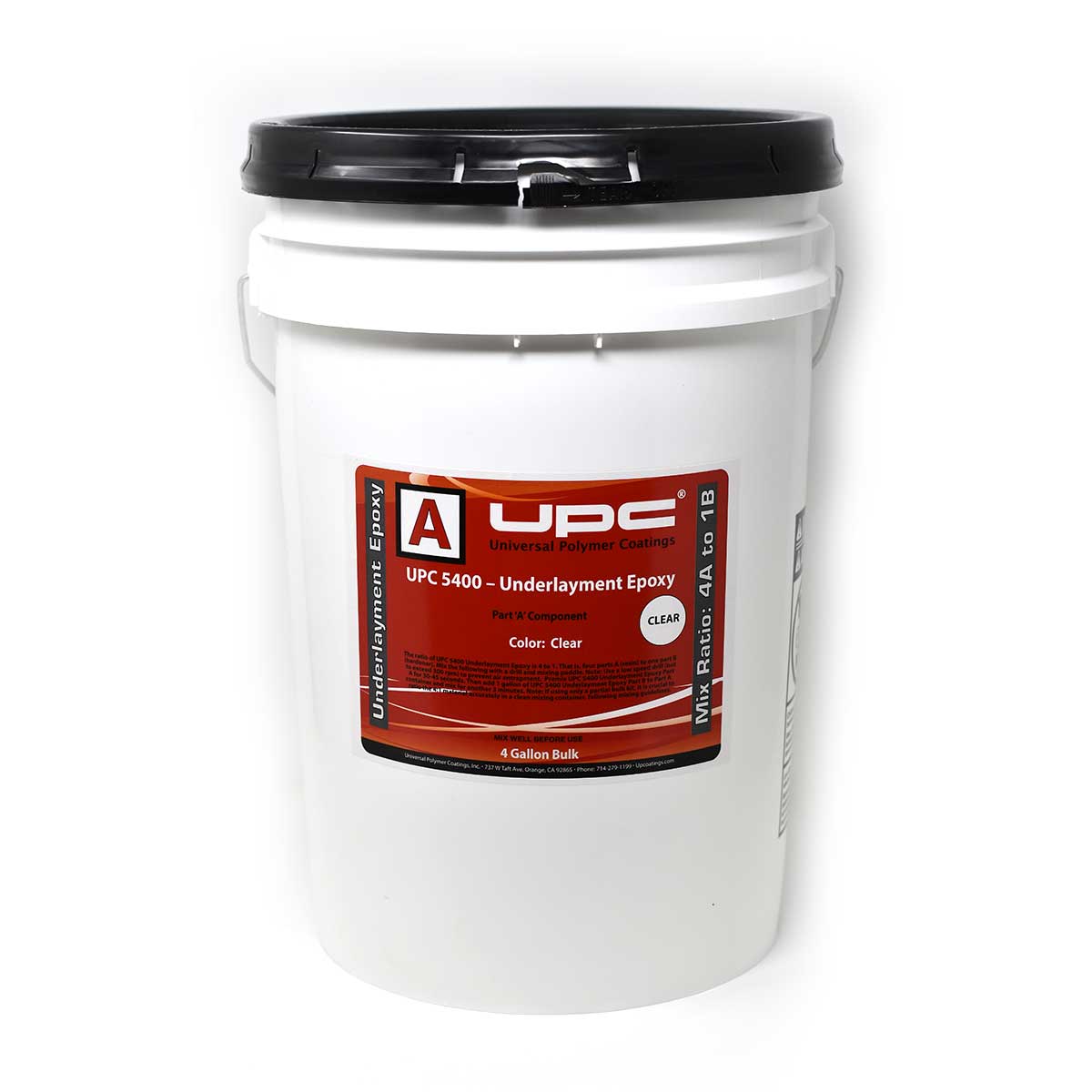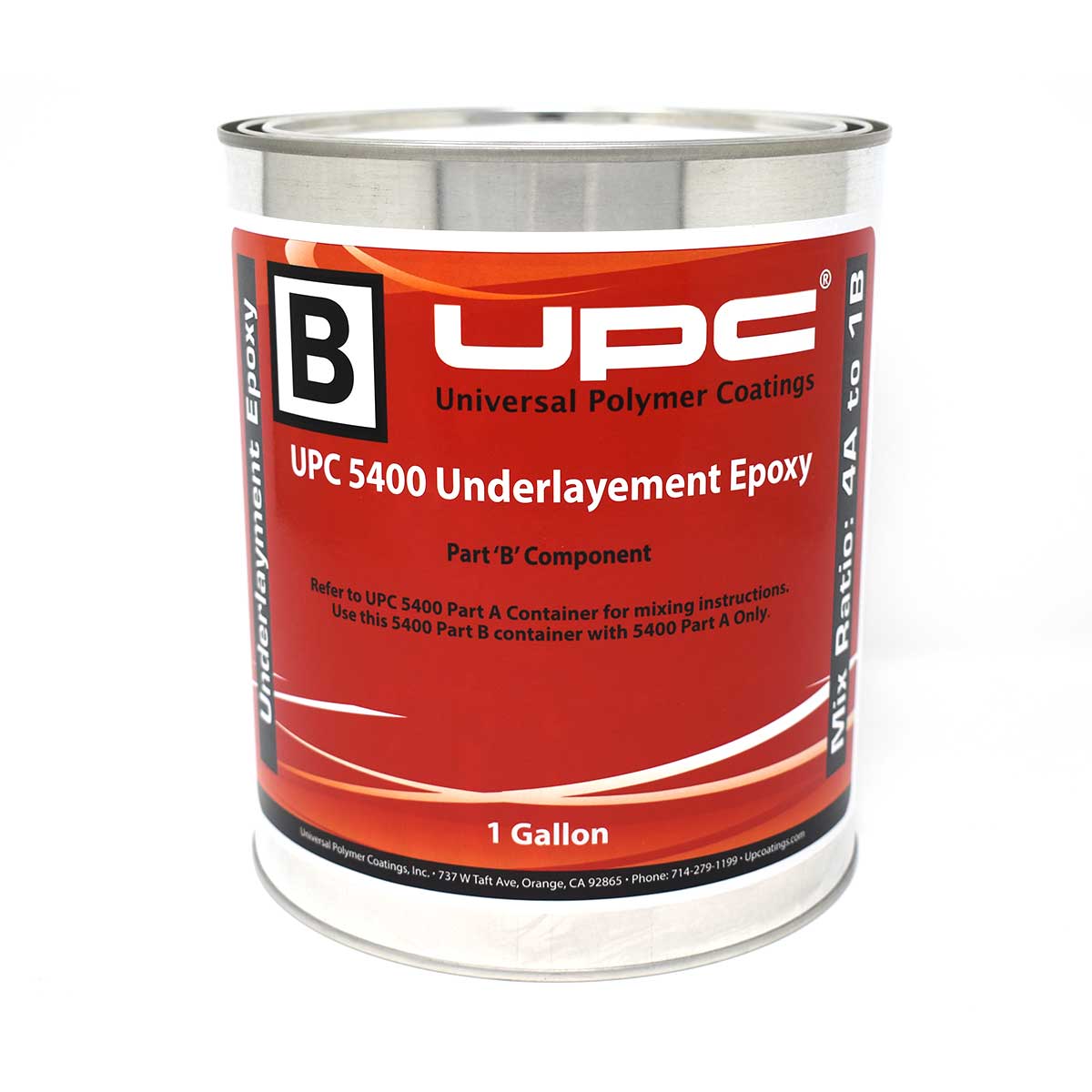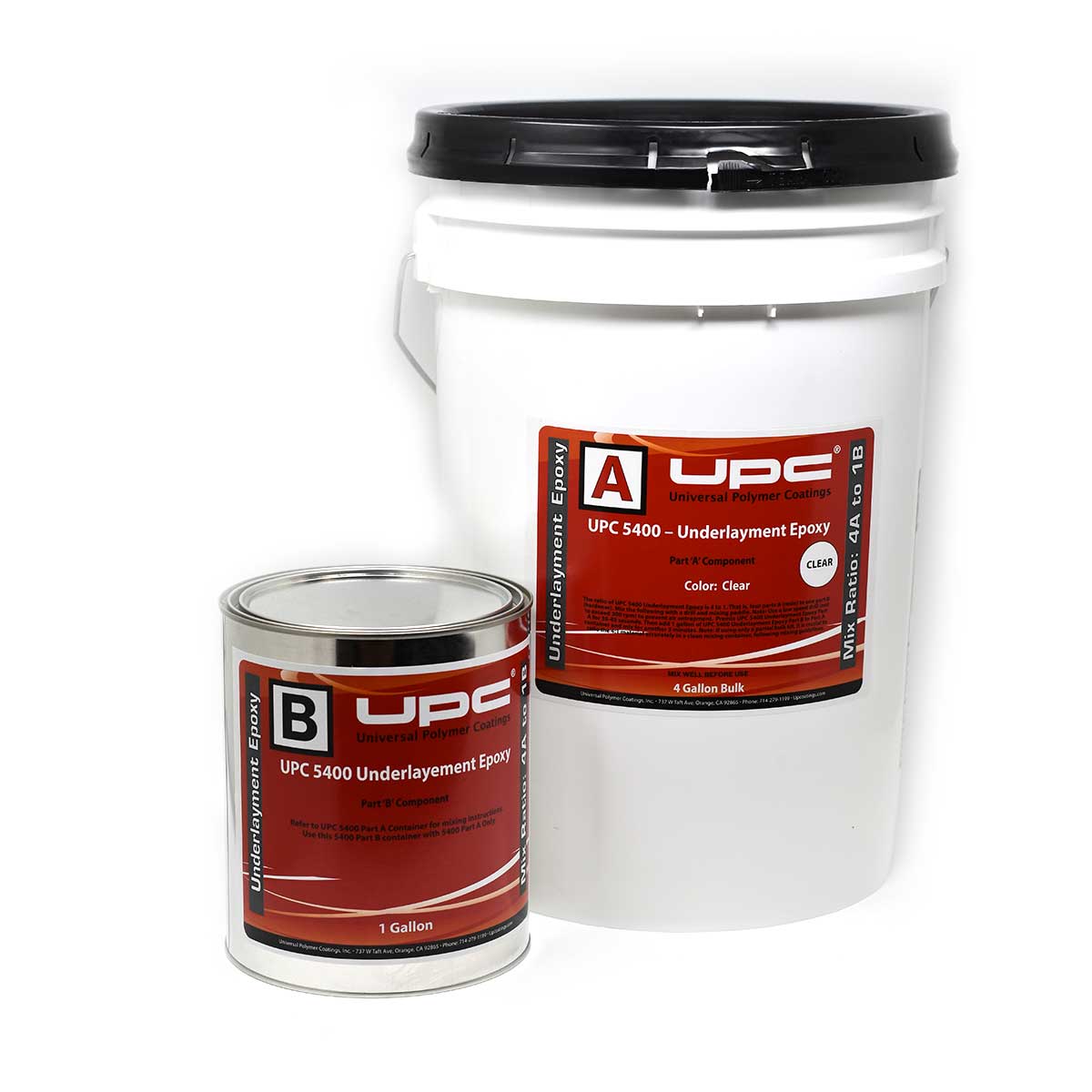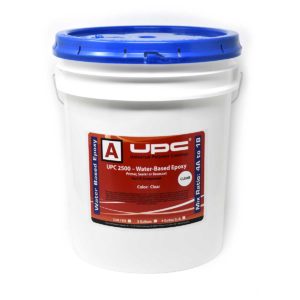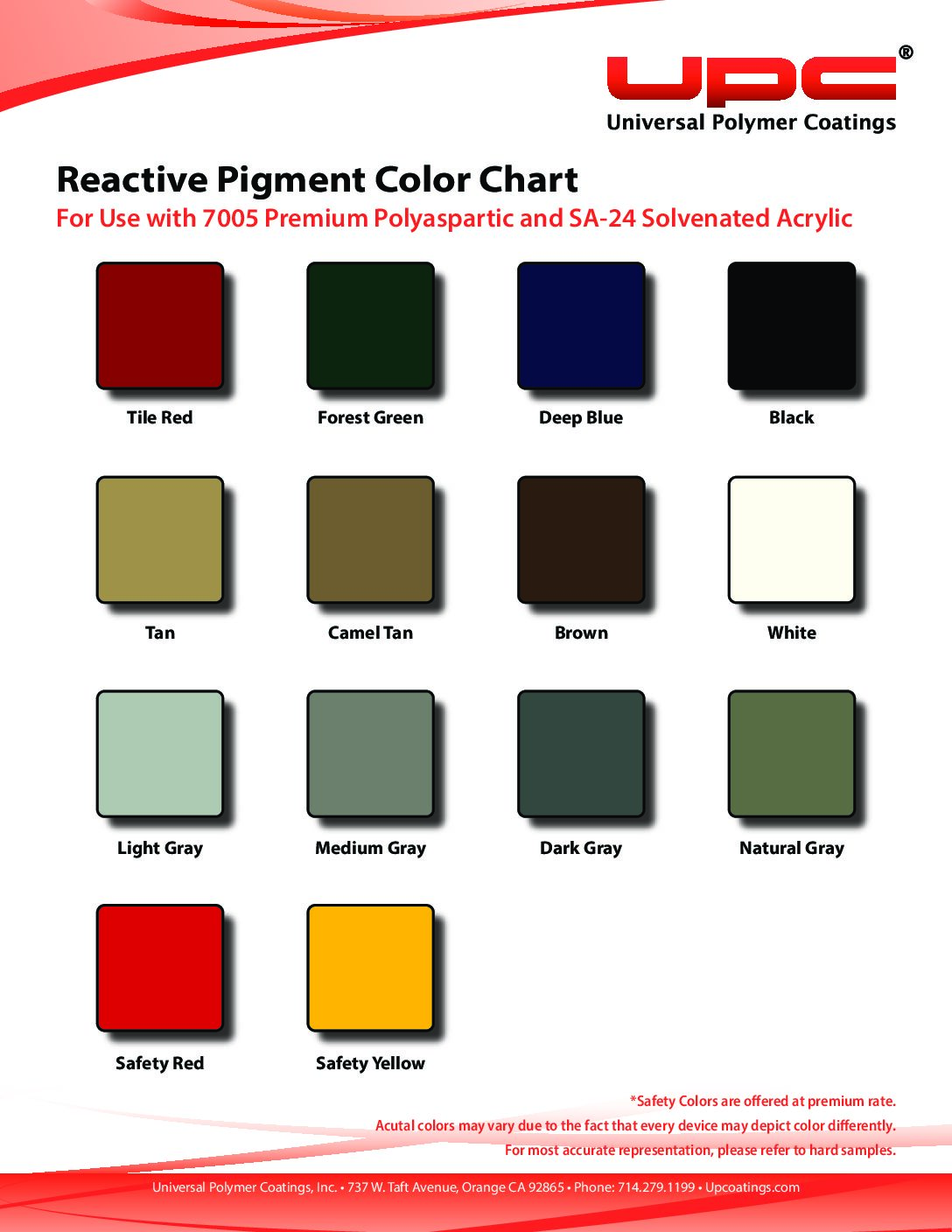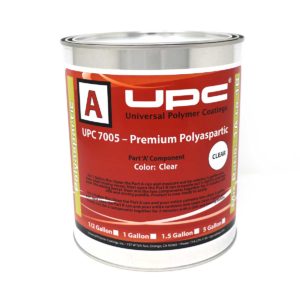UPC 5400 Underlayment Epoxy
UPC 5400 Underlayment Epoxy is an advanced, two-component high build epoxy flooring system. It is designed for use as a base coat or underlayment for leveling substrates. It is generally applied between 1/16” and 1/4” with silica. With the correct amount of silica, it is an excellent dry-pack material for sloping floors for drainage. UPC 5400 is usually used as an underlayment to make ready for approved cement products or UPC coating systems.
Download TDS:
Advantages
- Essentially Odorless
- Nonporous
- Seamless Flooring System
- No Amine Blush
- Lower Cost
- Resin Rich
- VOC Compliant
- Self-Priming
Applications
- Manufacturing floors
- Aerospace
- Trench and sumps
- Chemical flooring
- Secondary containment
- Production areas
- Waste Water Treatment Facilities
- Aisle ways
- Food preparation
- Loading docks
Colors
UPC 5400 Underlayment Epoxy is only available in Clear.
Packaging
UPC 5400 Underlayment Epoxy Kit consists of UPC 5400 Part A Resin and UPC 5400 Part B Hardener.
| Part A | Part B | |
| 5 Gallon Kit | 4 Gallon | 1 Gallon |
Patching
Voids, cracks, and imperfections will be seen in finished coating if the concrete is not patched correctly. Patch concrete with UPC Perfect Patch. After the patching material is cured, diamond grind patch. If a non-UPC patching material is used, contact a UPC technical representative for a compatible and approved alternative.
Testing
All surfaces are not the same. It is recommended that a sample area be done before the start of the project. The test should be done on-site, using the proposed method by the assigned applicator to ensure proper adhesion and color. A sample area should also be done on any existing coatings to determine if any contaminants exist or if delaminating will occur.
Physical Properties
| PROPERTY | VALUE | REFERENCE |
| Compressive Strength | 11,500 psi | ASTM C 579 |
| Flexural Strength | 4,100 psi | ASTM D 790 |
| Tensile Strength | 2,100 psi | ASTM D 307 |
| Bond to Concrete | 350 psi | ASTM D 4541 |
| Concrete fails at this point | ||
| Taber Abrasion | Loss/1000 | ASTM D 4060 |
| Cycles=25 mg | CS 17 Wheels | |
| Water Absorption | .10% max. | ASTM D 413 |
| Linear Shrinkage | .01% max. | ASTM C 531 |
| Flammability | 1.2 cm/min | ASTM D 635 |
| Impact Resistance | 16 ft/lb – no failure | Mil-D-3134H |
| Coefficient of Friction | 6 minimum | ASTM D 2047 |
| Hardness, Shore D | 84 | ASTM D 2240 |
| Porosity on Unglazed | 00 | NACE Stand |
| Finish | TM-01-74 | |
Product Data
| Volumetric Ratio: | 4:1 |
| Solids: | 100% (+ or – 1%) |
| Application temperature: | 65-90°F |
| Thinning: | Not required |
| Pot life: | 10-15 minutes |
| Working time on floor: | 20-30 minutes |
| Cure time: | 8 hours (walking) |
| 24 hours (traffic) | |
| Critical recoat time: | 24 hours |
| Shelf life: | 12 months |
| USDA Food & Beverage: | Meets requirements |
Concrete Preparation
Before coating is applied, concrete must be:
- Dry – No wet areas
- Clean – Contaminants removed
- Profiled – Surface etched
- Sound – All cracks and spalled areas repaired
Mechanical preparation is the preferred method of preparing concrete for coating application. Shot-blasting, diamond grinding, scarifying and scabbling are all acceptable methods.
Mixing
The ratio of UPC 5400 is 4 to 1. That is, four parts A (resin) to one part B (hardener). Generally, five mixed gallons of UPC 5400 at a time is ideal for application. Mix the following with a drill and mixing paddle. Note: If using a drill mixer, use a low speed (not to exceed 300 rpm) to prevent air entrapment.
- The 5 Gallon Kit allows the UPC 5400 Part A container to be used as the complete mixing container. Add entire contents of UPC 5400 1 Gallon Part B can and mix for 2-3 minutes.
- If less material is needed. Make sure to measure by volume 4 Parts A to 1 Part B. For example for 2.5 gallon mix. Measure out 2 Gallons of Part A and 1/2 Gallon of Part B.
Broadcast Application Instructions
The best method for controlling thickness during application is to map area out first. Determine the layout and square footage of the area, and calculate the required gallons of UPC 5400. Next, mark off on the floor how many gallons of resin are to be used by the time predetermined points have been reached.
- Pour mixed UPC 5400 onto concrete.
- Trowel or screed-rake the material until resin mix is uniformly applied. If a screed rake is used, trowel away pin marks left by the rake.
- Use a 3/8” nap paint roller. Lightly backroll resin, removing any unevenness left by the trowel or screed rake. This generally requires the use of spiked shoes, allowing one to walk in the wet resin mix.
- Wait 10-15 minutes while the resin mix self-levels and an even resin surface appear.
- Wearing spiked shoes, broadcast silica onto resin until resin is thoroughly covered. This method requires that silica be thrown upward and allowed to gently fall into the resin. Throwing silica directly at the resin mix will result in an uneven finish. Keeping a 1-2 foot wet edge where the next batch will be applied prevents ridges from appearing in the final finish.
- Excess silica can be swept up after the floor has cured for at least 8 hours.
Vertical Mix
UPC 5400 can be made into a vertical mix by following these steps:
- Measure out 1 Gallon of Part A and 32 oz. of Part B. Combine Parts together and mix well for 2 minutes.
- Slowly add Aerosil (Fumed Silicia) until mixture reaches desired thickness. Continue to mix material while adding Aerosil.
Clean-up
UPC 5400, while in a un-reacted state, may be cleaned up with water and degreaser. Isopropyl alcohol or acetone may be needed once the resin begins hardening.
Product Limitations
Ground-level concrete slabs emit invisible moisture vapor. The allowable moisture emissions for concrete are 3 lbs. / 1,000 SF over a 24-hour period based on a Calcium Chloride Test. Also, a Relative Humidity (RH) test can be performed to test for moisture vapor. RH testing results should be below 85% per ASTM F2170. If moisture is above this level, then blistering and de-lamination of coating may occur. A calcium chloride or Relative Humidity test should be performed to determine concrete moisture levels. If moisture levels exceed the 85% for RH test or 3 lbs. for Calcium Chloride, then a concrete moisture vapor control system should be used first before applying coating system. Recommended system for cases of moisture above acceptable levels is UPC 5200. UPC 5200 Moisture Lock passes F3010 spec based on E96 testing results. Please contact UPC representative for additional details.
Coating systems are susceptible to cracking if the concrete moves or separates below the coating. Hence, joint and crack treatment should be reviewed prior to coating application. As a general rule, control joints (saw cuts) and random cracks should be saw-cut or chased first then filled with UPC 777 Perfect Patch. Construction/cold joints (two slabs which meet and hence move) should be treated. After the coating has been applied and cured, saw cut through the coating over construction joints and apply elastomeric caulking.
Warranty
Universal Polymer Coatings products are warranted for one year after date of application. Please refer to the UPC Limited Material warranty for additional clarification.
Safety
Consult UPC 5400 safety data sheet. Avoid UPC 5400 contact with skin. Some individuals may be allergic to epoxy resin. Protective gloves and clothing are recommended.

